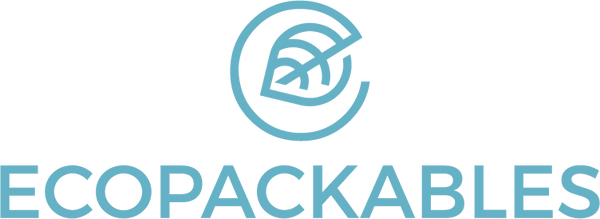Are you looking for sustainable, recycled or compostable polymailers to replace your current packaging and shipping needs?
Then this guide is for you!
Polymailers are one of the most popular forms of e-commerce packaging. At EcoPackables, we offer a variety of options for polymailers that are sustainable and eco-friendly. In this guide, we’ll go over the details of when to use a polymailer, each material option and packaging option currently available as well as how sustainability messaging can enhance your brand.

Poly Who?
The “Poly” in Polymailer is technically short for Polyethylene, the most commonly produced plastic primarily used for packaging, including plastic bags, plastic films, and containers. Plastics are made of chains of polymers which can be partially organic or fully synthetic and have plasticity, meaning they can be molded using heat, for example. The term Polymailer is supposed to mean a shipping mailer made from these polymers. Also called mailing or shipping bags, polymailer can often used to describe any sort of disposable flexible shipping packaging, whether it’s made of plastic, paper or compostable materials.
As technology advances, we are looking to replace the fossil-based polymers in plastics with renewable materials to create the next generation of PolyMailers and other Poly Bags that are renewable, ethically sourced with positive end-of-life prospects. While fossil-based plastics, recycled plastics, and compostable plastics are all polymers, they differ in terms of their environmental impact. Fossil-based plastics, which are made from petroleum, take hundreds of years to decompose and contribute to pollution. In contrast, recycled plastics, which are made from post- and pre-consumer waste, reduce the amount of plastic waste in the environment. According to a study by the Association of Plastic Recyclers (APR), recycled plastic reduced total energy consumption by 79% for PET, 88% for HDPE, and 88% for PP, and cut emissions over virgin material by 67% for PET, 71% for HDPE, and 71% for PP. Compostable plastics, which are made from biodegradable materials, can quickly break down into natural elements such as water, carbon dioxide, and biomass under the proper conditions. Our compostable bags are certified by all three industry certifiers; Vincotte, BPI and Dincerto, meeting American, European, International and Australian standards – including certifications for your domestic home compost. To gain these certifications, the product must break down within 90 days in commercial compost and 180 days in home compost conditions, including wormfarm compost. After degradation, they must leave no harmful residues behind. In fact, the only residue left behind is a soil enhancer which is returned to the earth as plant food.

When to use a polymailer
When deciding on packaging for your products, it's important to consider the specific needs of your items and customers. Polymailers can be a great option for many products, offering a lightweight, durable, and cost-effective solution. However, it's important to use them appropriately to ensure the safety of the product and satisfaction of your customers. In this section, we will explore when to use poly bags for different types of products, including shipping apparel and soft goods, books, cosmetics, healthcare, electronics, and fragile items, as well as considering product visibility. By understanding when to use polymailers, you can make informed decisions about your packaging strategy and improve the overall customer experience.

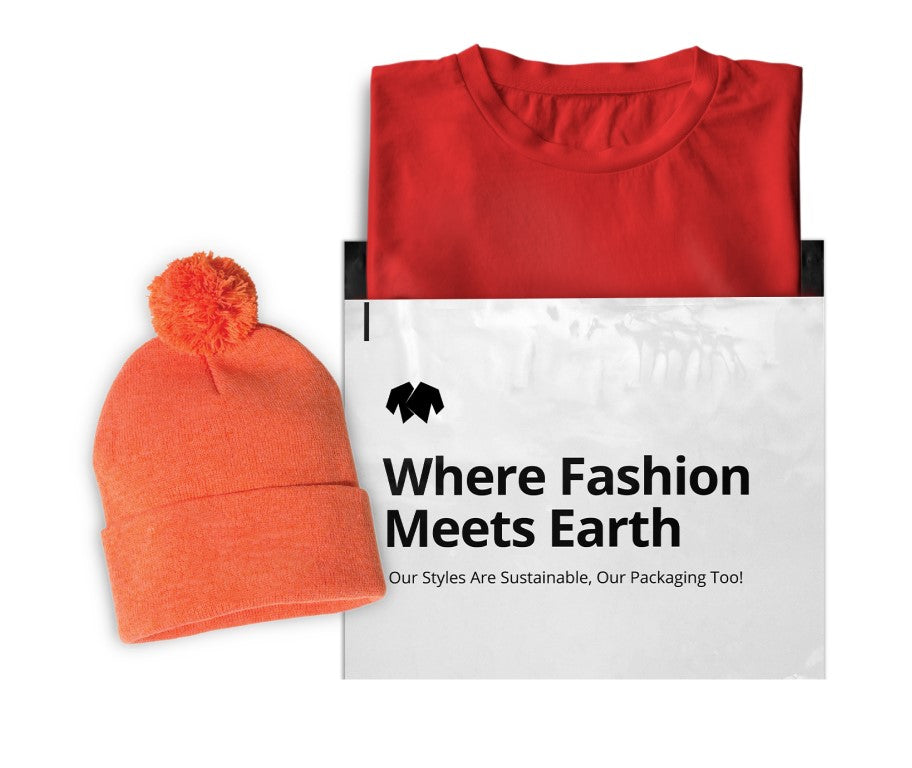
Shipping Apparel and Soft Goods
Our polymailers are perfectly suited to shipping apparel and soft goods. They are thin and lightweight while offering durability and moisture resistance. This makes them ideal for shipping items like clothing, beanies, scarves, purses, bedding, accessories and other soft goods that don’t need additional protection in the form of cushioned packaging.
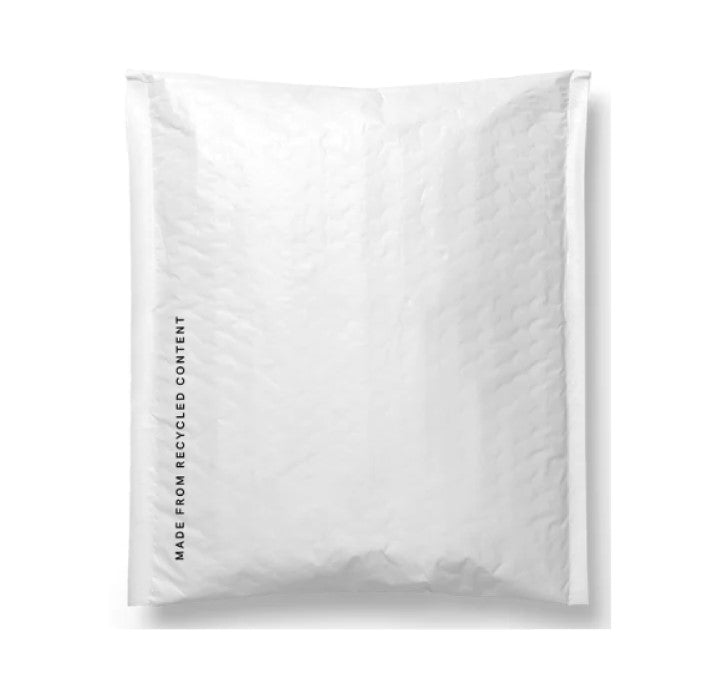
Books, cosmetics, Accessories and other fragile items
For those looking to ship fragile items such as books, cosmetics, accessories, healthcare products, electronics, and other delicate items, it is important to consider packaging options that provide extra protection. If you need protective packaging, but nothing as heavy duty as a box, consider our Recycled Bubble Mailers or Compostable Bubble Mailers. It's also important to ensure that the packaging is appropriately sized for the item being shipped to prevent movement and damage during transit.

Recycled plastic, compostables or recycled paper?
When it comes to sustainability, choosing the right material for your packaging is crucial. While recycled plastic, recycled paper and compostable materials all have their benefits, it's important to consider which option aligns best with your sustainability goals, customer needs and budget. When making this decision, it's important to consider your target market and their access to different waste streams. While compostable materials may be ideal for those with access to composting facilities, recycled plastic may be a better choice for those who have more limited access. Ultimately, both options have their benefits and should be considered carefully based on the specific needs of you and your customers. For a more indepth comparison of our material options, check out this article : Compostable vs recycled plastic vs recycled paper
Our Materials
When deciding on packaging for your products, it's important to consider the specific needs of your items and customers. Polymailers can be a great option for many products, offering a lightweight, durable, and cost-effective solution. However, it's important to use them appropriately to ensure the safety of the product and satisfaction of your customers. In this section, we will explore when to use poly bags for different types of products, including shipping apparel and soft goods, books, cosmetics, healthcare, electronics, and fragile items, as well as considering product visibility. By understanding when to use polymailers, you can make informed decisions about your packaging strategy and improve the overall customer experience.
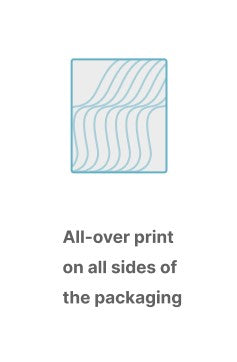

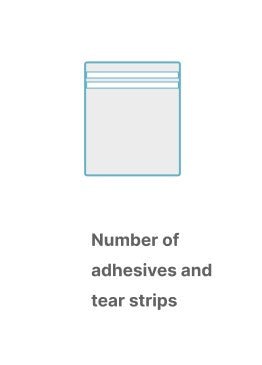
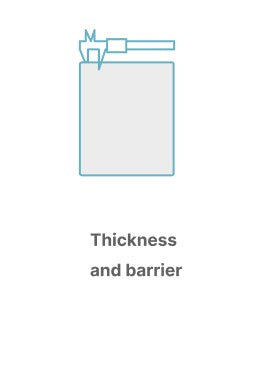
Compostable
Our 100% Compostable Materials are certified for both Home and Industrial Composting. They are certified by all three industry certifiers – Vincotte, BPI and Dincerto – meeting American, European, International and Australian standards, including certifications for your domestic home compost. To gain these certifications, the product must break down within 90 days in commercial compost and 180 days in home compost conditions, including wormfarm compost. After degradation, they must leave no harmful residues behind. In fact, the only residue left behind is a soil enhancer which is returned to the earth as plant food. We found that our mailers performed much better than conventional plastic, in the sense that they don’t break at the bottom when put under heavy weight, and are equally waterproof. Instead, they are tear-resistant by stretching to distribute the weight over the whole bag, rather than in just one section. This makes them much more robust, especially for repeat uses! To ensure maximum longevity, we recommend you store EcoPackables compostable products in a dark, dry place. Doing so ensures they remain strong enough to ship parcels globally for 9-12 months. Ordering every 6 months is recommended to maintain strength.
We’re always on the lookout for new materials to diversify our production; PBAT (short for polybutylene adipate terephthalate) is a bio based polymer which is compostable. The cornstarch used in our mailers is made from discarded corn that is no longer fit for human consumption, and makes up barely 0.05% of the annual global corn crop. This makes it an incredibly low-impact resource. We are still working on getting our mailers to be 100% renewable. Unfortunately, PBAT is partially made from fossil resources, and R&D on sustainable materials takes time. However, we are currently in the process of testing new plant-based materials with the support of Yale University- so watch this space!
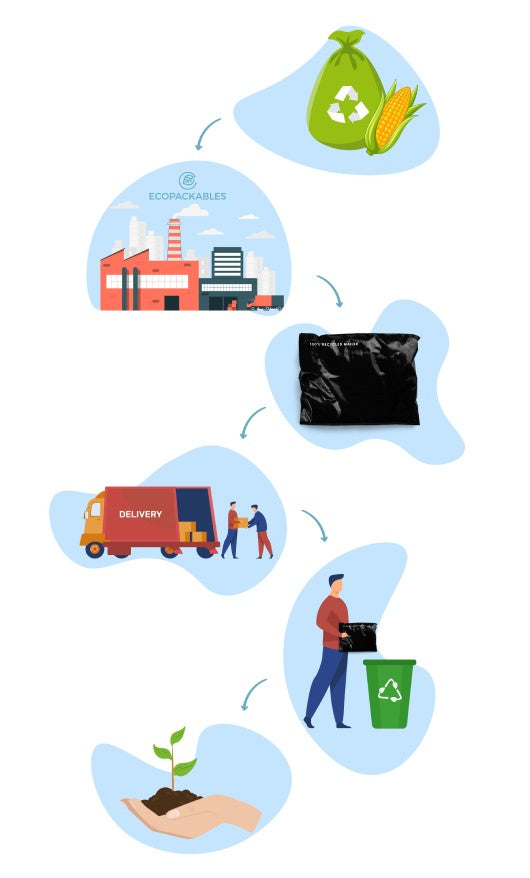
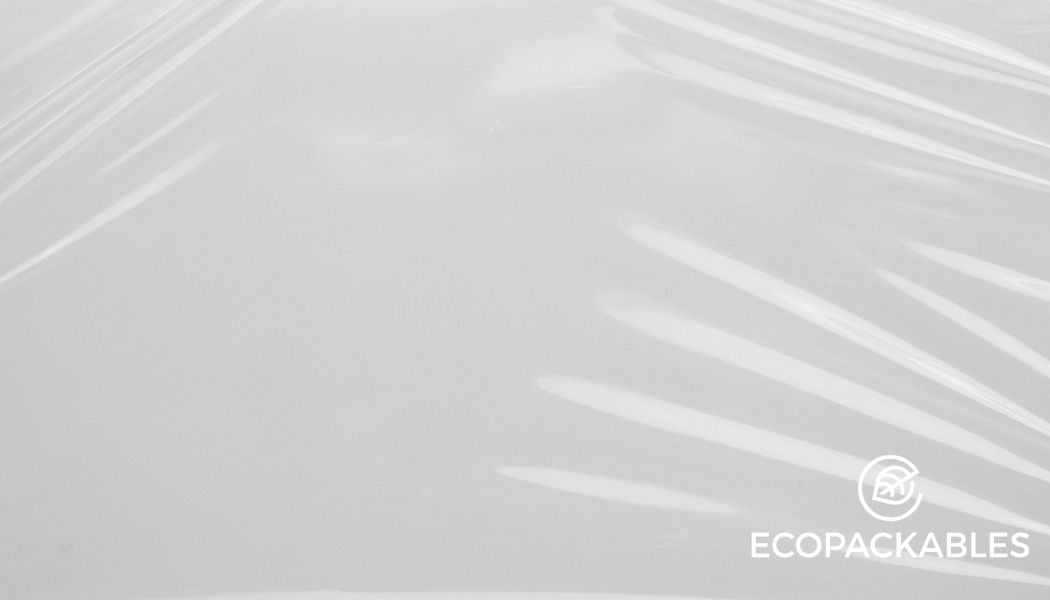
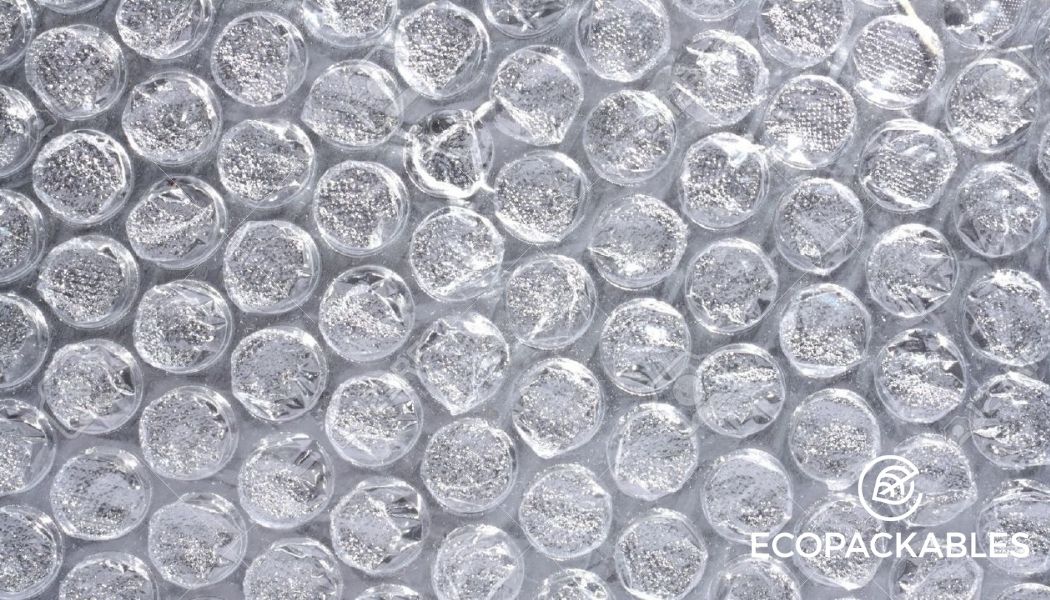
EcoPackables D42 Film
EcoPackables D41 film
EcoPackables D42 Bubble
This Semi-Opaque Compostable Film is made from a unique blend of Cornstarch and PBAT, a bio-based polymer. Both sides are sealable and printable, with thickness ranging from 30-110μm. Colors can be customized.
This transparent film is made from a unique blend of Cornstarch and PBAT, a bio-based polymer. Both sides are sealable and printable, with thickness ranging from 20-100μm. Used as a single layer in laminates.
A Semi-Opaque Compostable Film made from a unique blend of Cornstarch and PBAT, a bio-based polymer. Often paired with a recycled kraft exterior, or with EcoPackables D42 Film. Colors can be customized
Compostable Mailers

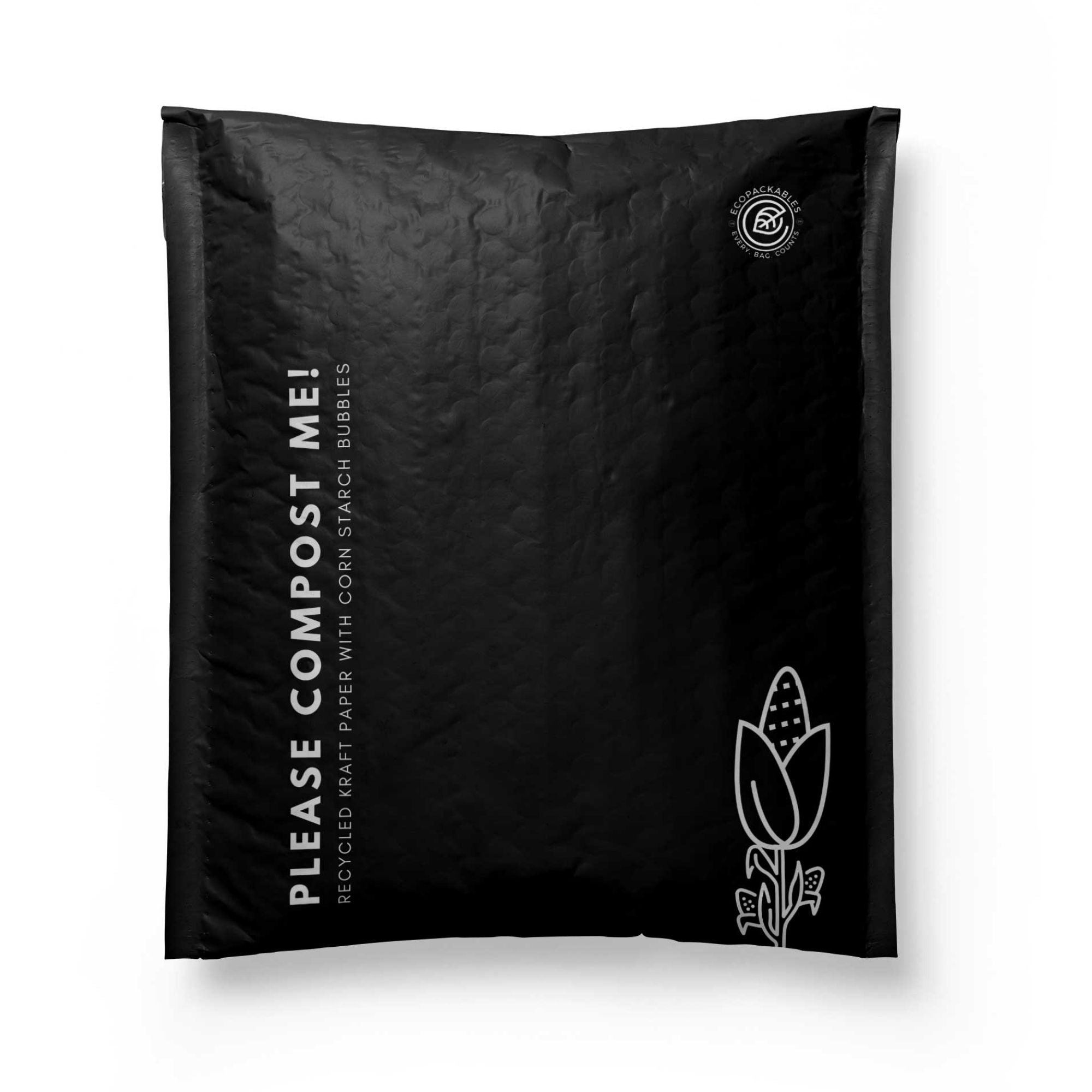
Compostable Mailer
Compostable Bubble Mailer
- 100% compostable, made of a unique blend of cornstarch, PLA, and PBAT
- Perfect for non-fragile items such as apparel, soft goods, and accessories.
- 100% compostable, made of a unique blend of cornstarch, PLA, and PBAT
- Perfect for books, cosmetics, healthcare, electronics, and fragile items
- Printed with water based inks
Recycled Plastic
Recycled plastic materials are becoming increasingly popular in packaging due to their environmental and cost-effective benefits. Our GRS 4.0 Certified recycled plastic is moisture, tear, and tamper-resistant and sourced from both pre-consumer and post-consumer waste. Pre-consumer waste refers to scraps from the manufacturing process that have never reached the end-user and are diverted from the waste stream. In contrast, post-consumer waste is material that has already been used by consumers and is collected for recycling. Using recycled plastic materials in packaging reduces the amount of plastic waste that ends up in landfills or the ocean. It also conserves energy since recycled plastic requires less energy to produce than virgin plastic. Our recycled plastic is printed with Water-Based inks and even recyclable at thin film drop off locations and can be used to make new products. Recycled plastic mailers may not have the same print quality as virgin plastic, and often contain impurities. We see these impurities as a positive sign of the circular economy in play. We are able to adjust the ratio of post and pre-consumer waste for a higher print quality, however, we encourage embracing the impurities and natural feel of the mailers as a testament to the use of sustainable materials.
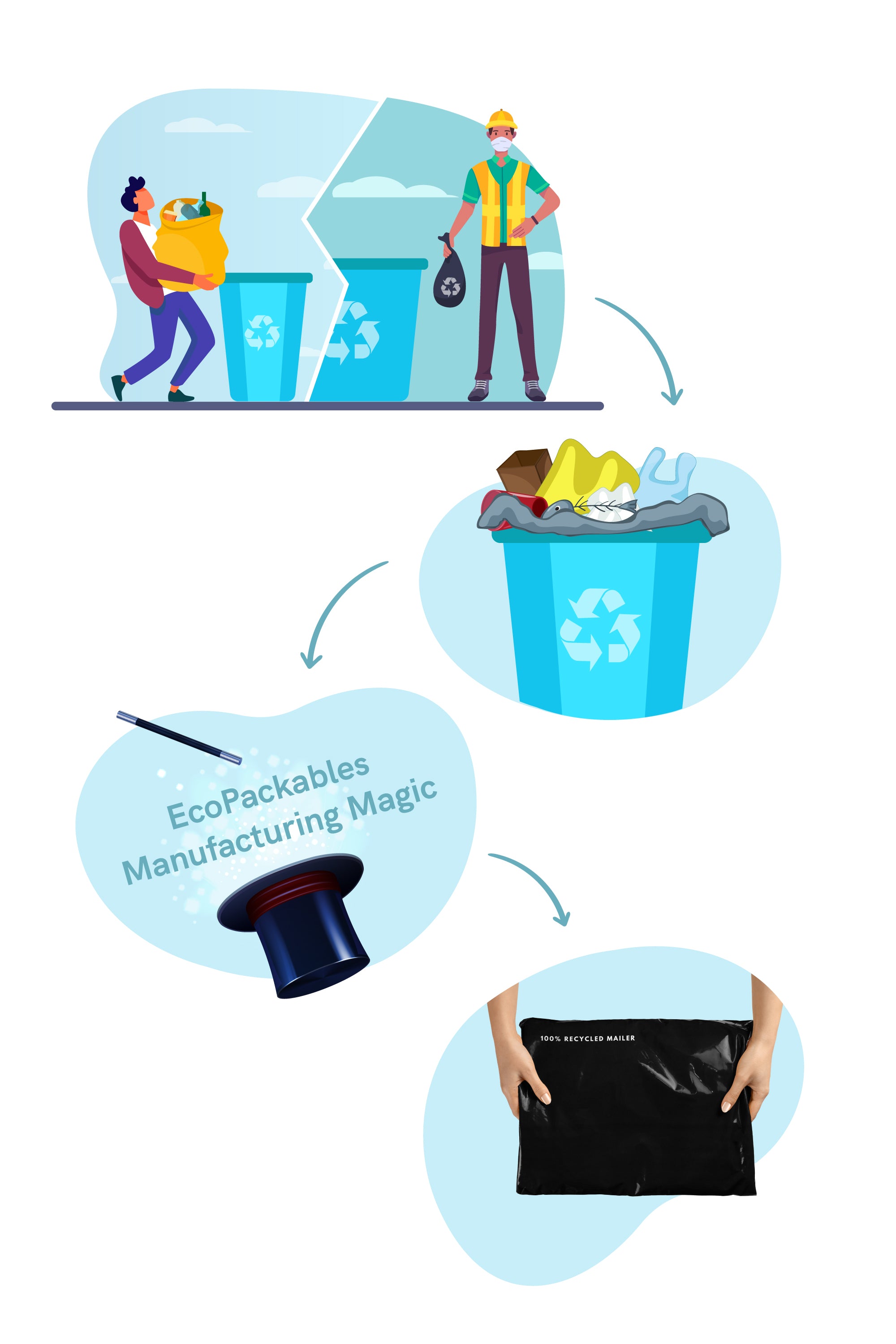



EcoPackables D39 Film
EcoPackables D38 Film
EcoPackables D39 Bubble
GRS 4.0 Certified Film that is made from a blend of pre-consumer (50-75%) and post-industrial waste (25-50%). Can be customized according to specification on the product and desired print quality. (30-110μm).
Fully transparent GRS 4.0 Certified Film that is made from 100% Post-Industrial Waste. Single-layer film used for garments and other applications that require high transparency. Thickness (30-110μm).
GRS 4.0 Certified Film that is made from a blend of pre-consumer (50-75%) and post-industrial waste (25-50%). Often paired with a recycled kraft exterior, or with EcoPackables D42 Film. Colors can be customized.
Recycled Plastic Mailers
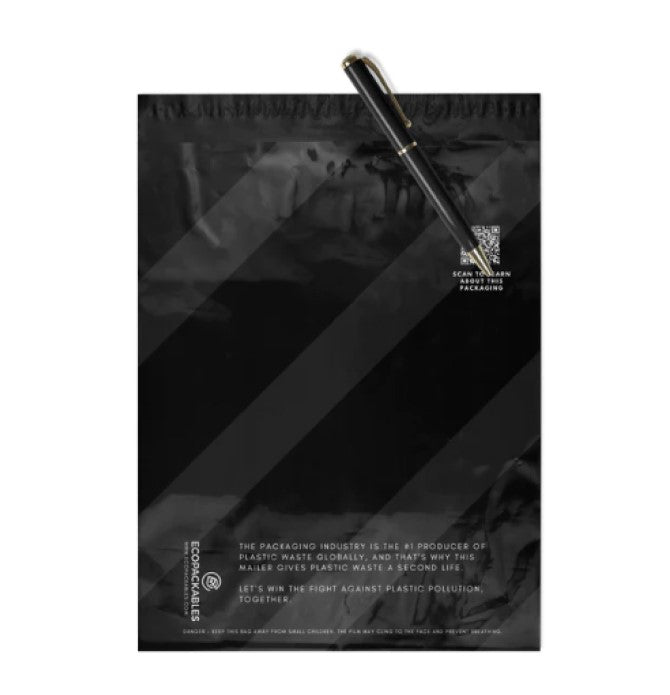

Recycled Polymailer
Recycled Bubble Mailer
- Printed with Water-Based Inks
- Certified by the GRS 4.0
- Made from 65% post-consumer recycled waste and 35% pre-consumer waste
- Fully recyclable with thin film and at drop-off recycling bins
- Moisture, tear, and tamper-resistant
- Perfect for non-fragile items such as apparel, soft goods, and accessories
- Printed with Water-Based Inks
- Certified by the GRS 4.0
- Made from 65% post-consumer recycled waste and 35% pre-consumer waste
- Fully recyclable with thin film and at drop-off recycling bins
- Moisture, tear, and tamper-resistant
- Perfect for books, cosmetics, healthcare, electronics, and fragile items
Recycled Paper
Recycled Kraft paper is a sustainable material choice offering several benefits. Our 100% Recycled Papers, which are FSC Certified and made from responsibly sourced paper pulp and post-consumer recycled waste, contribute to reducing the paper industry's impact on the environment. While recycled paper has a lesser environmental impact, it can be more costly and may not offer the same level of moisture protection as a plastic-based alternative.

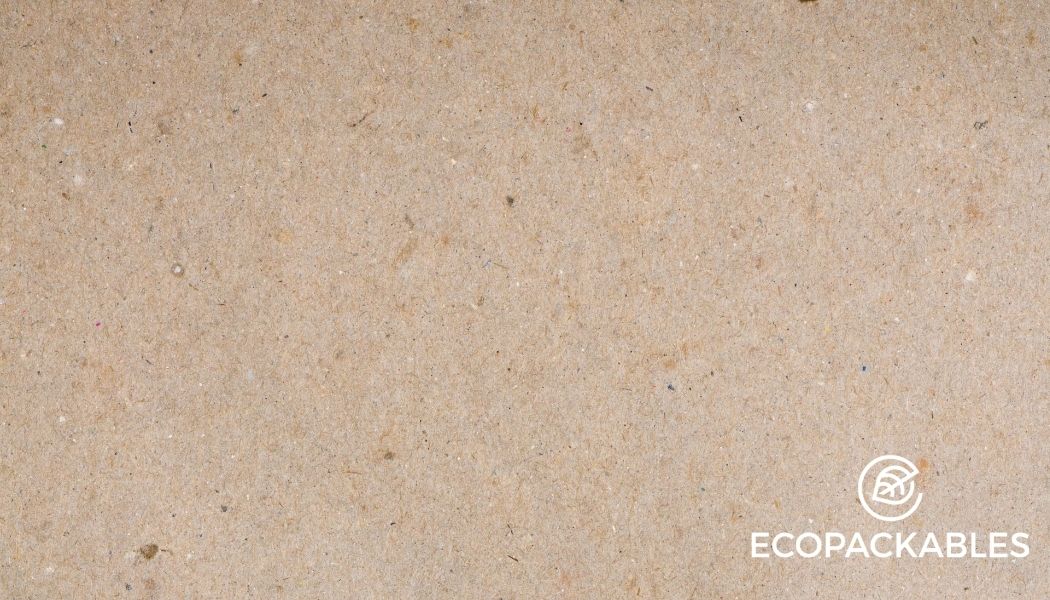
Recycled Kraft
FSC-Certified Post-Consumer Recycled Paper that is printed on with non-toxic inks. Heavily customizable and available in 90-330gsm.
Recycled Paper Mailers

Recycled Kraft Mailer
Recycled Honeycomb Padded Mailer
- 100% post-consumer recycled paper
- All-over custom print available
- Natural kraft or white paper finish
- Can also be made Expandable at 5,000 MOQ*
- Compostable and recyclable
- FSC-Certified
- 100% recycled paper
- All-over custom print available
- Extra protective padding
- Compostable and recyclable
- FSC-Certified
Materials Comparison

Branding and Sustainability Messaging
Know Your Customer
Understanding your customers is crucial when developing a sustainability strategy and brand messaging for your polymailers. Start by identifying your target audience's and what matters to them, including their attitudes and beliefs towards environmental issues. By knowing your customers' preferences, you can create messaging that resonates with them, which can help build brand loyalty and attract new customers. It is also important to consider the recycling and composting infrastructure available to your customers and provide them with clear information on how to dispose your packaging.

Tell Your Sustainability Story And Educate Your Customers
In order to make a significant change in your packaging, it is essential to have an effective packaging story. While many companies invest resources in developing new packaging systems, they often neglect to update the messaging on their packaging. To create a compelling packaging story, it is important to highlight your company's sustainability commitments and the materials used in your packaging. This serves two purposes: it enhances your brand by demonstrating to consumers that you are an environmentally responsible company and it educates consumers on sustainability, thus increasing their expectations for sustainable packaging and pressuring other companies to follow suit.If your brand is transitioning from glossy, flood-coated mailer boxes to a more environmentally-friendly kraft alternative, it is crucial to communicate the reasons for this change to your customers. You can do this by clearly illustrating the environmental benefits of recycled materials, less ink, and an uncoated box on the physical product or via a QR code. By educating your followers, you help to establish a new norm for sustainable packaging.
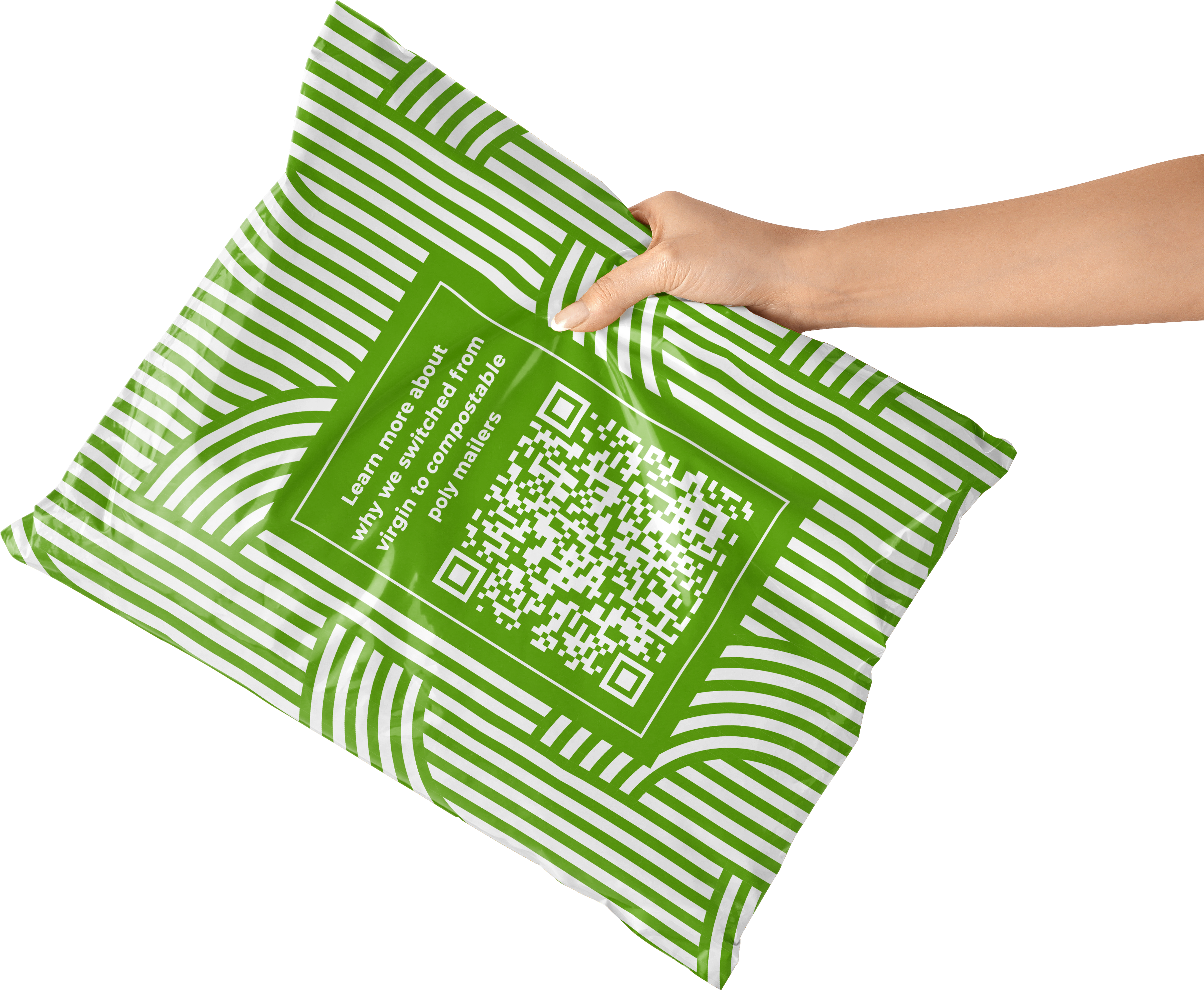
where to start
If you're interested in sustainable mailer packaging, congratulations! You're taking the first step towards a more eco-friendly and responsible approach to packaging. Now that you know all of your options, let's begin your sustainable mailer packaging journey!
The first step is to determine if a mailer is the right fit for your product packaging needs. After that, you need to decide which mailer material you'd like to use. Compostable and recycled polymailers are popular sustainable options. It's important to consider the footprint, end-of-life, and aesthetics of each option before making a decision.
Once you've decided on the material, you can figure out which size is best for you by trying out our stock sizes, requesting your own dimensions, or having one of our engineers find the best size for you. With your size in mind, it's time to design your mailer with full CMYK digital printing with brand and sustainability messaging. Make sure that your design aligns with your sustainability story and messaging, as this is crucial for successful branding.
When you're happy with your design, it's time to place your order and approve the final artwork. Once you've approved the artwork, your order will be put into the queue, and the lead time will begin! We're here to help with any step of the process, so don't hesitate to reach out for assistance.

